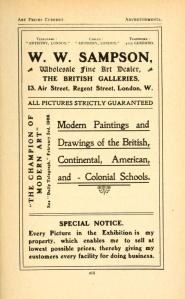 While researching my family tree, I discovered a great deal of unexpected links to the art world through the late Victorian, to the Edwardian era, and from there, connections to what appeared to be the beating heart of a world rushing towards technological advancement, with London at its epicentre. Through my Great Grandfather, Henry Ramus, I have found myself unearthing a story which eminates outwards from the artist, John William Godward, and his seemingly biggest patron, William Walker Sampson, (who also happened to be Henry’s business partner), and on to some of the biggest names in the world of art, literature, entertainment, and industry. From Gaiety girls, and Stage Door Johnnies, to the old money of Europe against the new money of America, it seems that life as we know it now, with oligarchs, their fortunes, and their ambition to use that wealth to secure some kind of immortality through art collections, little has changed in the last hundred years or so. The difference is in the setting, but the human aspect seems curiously unchanged.
While researching my family tree, I discovered a great deal of unexpected links to the art world through the late Victorian, to the Edwardian era, and from there, connections to what appeared to be the beating heart of a world rushing towards technological advancement, with London at its epicentre. Through my Great Grandfather, Henry Ramus, I have found myself unearthing a story which eminates outwards from the artist, John William Godward, and his seemingly biggest patron, William Walker Sampson, (who also happened to be Henry’s business partner), and on to some of the biggest names in the world of art, literature, entertainment, and industry. From Gaiety girls, and Stage Door Johnnies, to the old money of Europe against the new money of America, it seems that life as we know it now, with oligarchs, their fortunes, and their ambition to use that wealth to secure some kind of immortality through art collections, little has changed in the last hundred years or so. The difference is in the setting, but the human aspect seems curiously unchanged.
.
What is here is the tip of an iceberg, it spreads so far and wide, encompassing art, photography, literature, the birth of motor cars, aircraft, engine technology, travel in all its forms. It brings characters that came from nowhere, and found themselves mixing with royalty, as well as the super rich magnates from America. Sampson, who had been born illegitimately in Tynemouth, adopted son of a seaman, sold newspapers on the streets outside Newcastle railway station, saw his first gallery on a school trip to Cragside, Northumberland, skipping the feast laid on for the boys to sneak a second glance at Sir John Millais’s ‘Jephtha’, heading south to Harrogate where he begun his art dealing career with Dyson Lister, before making his way to the art capital of the world, London, and rising to head possibly the biggest art cartel of his time. Harry Preston, who from being a teacher, decided he wanted to taste the life of dockland London, became a shipping clerk, before taking up the running of ale houses, and illegal boxing bouts, finally moving into the hotelier business, and finishing up as owner of hotels in Bournemouth, and Brighton, not to mention giving the likes of Edward the 8th the benefit of his wealth of knowledge regarding the noble art of pugilism. Not forgetting A.S.W.Rosenbach, a giant of the book selling and collectors world, who even more so than Sampson, or Preston, would fill column inches in newspapers across both sides of the Atlantic with his auction room conquests.
.
There are other characters of whom you will not have heard, but had you lived in their time, you would likely have known of them at least. I would call this an antidote to Downton Abbey, a story of some of the people that helped shape the time they lived in, and far more interesting because it’s real.
.
Through this research, I met an eminent art historian, Vern Grosvenor Swanson, who has since asked me if I would be interested in writing a piece for the ArtRenewal website, (apparently one of the biggest of its type in the world), explaining the ‘art ring’ that William Walker Sampson was running from about 1900 to his death in 1929, what follows is a beginning.
.
(Please bear in mind that this is a work in progress, very much a ‘rough out’ to work with)
The ‘Ring’
.
‘In these auctions there is a private feature for which one must always be on the alert, this is called ‘La Graffinade’. It consists of a ‘ring’ of dealers who do not outbid each other in the sales… These sharpers thus become masters of the situation, for they manage matters so that no outside buyer can bid above one of their own ring. When a thing has been run up sufficiently high to prevent any outside bidder making a profit, the ring meets privately, and the article is allotted to one of the members. This arrangement accounts for the high prices which surprise so many persons of experience. The ring does not wish the article to re-appear in the auction room, less it should fall to a lower price than at which they pretend to have acquired it. This conspiracy against the purse of private persons has driven from the auction room a large number of buyers….’
.
(2):- Louis Sebastien Mercier gave this enlightening commentary on an eighteenth century dealers’ ring in his:-
‘Tableau de Paris’: (Panorama of Paris, written 1781–8)
.
The Ring explained
.
While researching my Great Grand father, Henry Ramus, I discovered, (courtesy of an ArtRenewal website article on the Victorian artist, John William Godward by Vern Grosvenor Swanson), that he had been in business with a William Walker Sampson, as Fine Art Dealers during the late 1800’s and early 1900’s. That same article named Sampson as being head of an art cartel, or, ‘Ring’ leader. Researching Sampson led me in to a world that involved some of the most eminent people in the country at the time, and to a closer understanding of the mystery of the Auction ‘Ring’, the ‘Knockout’, and the, ‘Knockback’.
.
My remit here, is not to discuss any rights or wrongs of a dealers ‘Ring’, (it wasn’t illegal at the time), but to show that, if such a thing existed in London during the early nineteen hundreds, there was compelling evidence pointing to William Walker Sampson being a ‘Ring Master’ of Christies and Sothebys at this time, and head of the most prolific Ring of this period, until his death in 1929 in Brighton. It is my hope, that this article should raise enough questions to at least suggest a more in depth investigation would be worthwhile, which, with a close analysis of Sothebys and Christies sales records from the period, should hopefully reveal a definitive answer as to whether W.W. Sampson was indeed head of an organised Ring, how successful it was, and how eventually it may well have led to his financial ruin..
.
Below are two more descriptions I’ve found which should give the reader an idea of what the Ring represents:-
(1):- ‘Pedigree and Panache: A History of the Art Auction in Australia’ (page 13)
By Shireen Huda
” The aim of the ‘Ring’, usually consisting of a group of dealers, is to reduce the competition and buy the intended work(s) for lower prices than would be achieved in a truly competetive marketplace; that is, beneath real market value. The members of the ring, rather than the original vendor and auctioneer, therefore reap the financial benefits. “
.
(2):- Hansard House of Commons records:-
ANTIQUE DEALERS (RINGS)
House of Commons Debate 23 December 1964 vol 704 cc1241-59 1241
12.13 p.m.
Mr. R. Chichester-Clark (Londonderry) “I am grateful for this opportunity of raising once again in the House the shabby practice of the ‘knockout’.”
“After recent revelations concerning this form of commercial brigandry, which is really what it is, I think that the House is fairly familiar with how these rings operate, but to get it on the record perhaps I may quote something which I have borrowed from elsewhere and which I have somewhat adapted. It describes fairly well and succinctly the operations of the ring. It says: A group of antique dealers decide to apportion the lots at a given sale, in advance, so that no underbidder may bid against the party chiefly interested. The antiques, therefore, change hands at a price much below their market value. This value is established at a second sale outside the auction room and the difference between the two prices is divided between the antique dealers concerned as a dividend offered in exchange for forbearance. That fairly well sums up the method. But I should perhaps add that in some cases—this is especially true in the provinces—it is not necessary to reach agreement or apportionment beforehand. This is because one member of the ring in given areas knows another and because in many cases, after many incidents, practice has made perfect.”
.
“There was the knockout graphically described by the Sunday Times as having taken place in the “hired snug” in a hotel. There, it is said, the ring had a poor day because after the first round those who dropped out received only £1 apiece. However, it is accepted I think, that the final round of some knockouts can be very exciting indeed. Three or four dealers may still confront one another; they are the experts in their subjects; and the ultimate shareout in the would-be final round can be about £1,000 apiece. Small wonder that one of those who, I believe, had been engaged in this practice described the process as ‘twice as exciting as poker’.”
———————————
.
William Walker Sampson
.
William was born in Tynemouth, 1865, to Margaret Walker, (eldest daughter of John Walker, and Mary Ann). On February 9th, 1869, Margaret married Charles Sampson, both of them aged 24 at the time, with Charles profession given as, ‘Mariner’, his father named as, Henry, whose profession was listed as, ‘Grocer’, while Margarets father, John, is listed as being a, ‘Waterman’. They were married at the parish church of Tynemouth, Northumberland, a maritime and mining community, and by the 1871 census, living at Little Bedford Street, Chirton, Northumberland, William has had the Sampson surname added to his full name.
.
On the 7th August 1887, William Walker Sampson married Elizabeth Colston, daughter of James and Elizabeth Colston, a Scottish family from Dunse, Berwickshire. They both give their ages as 22, while William names his father as, Charles Sampson, profession- Ship Captain, Elizabeths father is named, James Colston, profession- Painter. They were married at the parish church of Jesmond, Newcastle Upon Tyne, Elizabeths younger sister, Helen (Nellie) Colston is a witness on the certificate. Williams profession is given as, ‘Clerk’. On 28th September 1890, William and Elizabeth had a son, John (Jack), born Newcastle Upon Tyne, Northumberland., Williams occupation here given as, ‘Commercial Clerk’.
.
Since beginning on this road of research into Sampson, I have discovered a lot of information regarding the world of Victorian art dealing, not least of which was the modus operandi of greasing the palms of butlers, valets, and other servants in a position to spill the beans on their wealthy employers, especially regarding the works of art in a lot of the country’s stately homes. It is with this in mind that I mention now the 1891 census report for Williams wife, Elizabeth, where she, her sister, Nellie, and Williams sister, Lizzie, his Aunt, Mary Walker, and young Jack (John) Sampson, now six months old. They are living at Temple Grove, Mortlake, Surrey, and Williams sister, Lizzie, now aged 20, is a Scullery Maid, his wifes sister, Nellie, is a Servants Hall Maid, his Aunt Mary is a cook, while his wife, Lizzie, and boy Jack, are listed as Visitors.
.
So far, so what?, I hear you ask yourselves, until you discover that the residence they are staying at is that of their Royal Highnesses, the Duke and Duchess of Fife, but not just any old Duke and Duchess, this Duchess was Louise Victoria Alexandra Dagmar, the younger sister of George V and the fifth daughter of a British monarch to be styled Princess Royal..
Mortlake is some 285 miles from Tynemouth, half the length of the country, so however one looks at this situation, it’s quite some set of circumstances that would lead to Williams family members travelling that distance, in those days, to arrive at them all landing a job with Royalty.
.
A little after this time, the links between William, and my Great Grandfather, Henry Ramus, begin to come up. When Henry married May Simmons on the 21st December 1899, their address was given as, 21 Mecklenburgh Square, Henry stated as being an Art Dealer. In the 1901 census, William Walker Sampson, along with his wife and son, are now living at 21 Mecklenburgh Square, Williams occupation given as, ‘Fine Art Dealer’. Living at that same address in the 1891 census, was Henry’s Uncle, Benjamin Ramus, whose, by then de facto wife, Rose, was the mother of Henry’s wife, May. In the Post Office Directory of 1902, Henry Ramus is listed as, ‘Henry Ramus &Co, fine art dealers’, at 68 Wardour Street, whereas, in the 1898 Electoral Registers for London, William Walker Sampson is listed as living at 67 Wardour Street. To show further the strength of the bond between William and Henry, when Henry and May have their second child, he is named, Neville Walker Simon Ramus (4th Feb 1904)., giving him Sampsons middle name.
.
While Sampson was married, he was having an affair with Simeta Sampson, (they weren’t related), at least thirteen years before he married her after the death of his first wife, Elizabeth. The two of them are on the 1911 census, staying at the Queens Hotel in Leicester Square, London. The hotel was run by Harry Prestons sister, Winifred, and her husband, Edward Wrixon Bayley, and a Bernard Alfred Quaritch was also staying there at the time, a world renowned bibliophile and auction friend and rival to Dr Rosenbach, (whose role in this article I explain further on, as well as that of Harry Preston), but there can be no doubt that Sampson and Quaritch would have known each other from crossing paths at Sothebys and Christies. Simeta gives her profession as, ‘Actress’, in the census, her sisters had been, ‘Theatrical Choristers’ in the 1891 census, and it would seem she had followed them on to the stage, perhaps snagging William as a ‘Stage Door Johnny’, named so as a result of the large amount of relationships that sprang from the profession, actresses often going on stage precisely to bag a man of means.
Simeta’s acting name was Simeta Marsden, taking her mothers maiden name. She was clearly a big name in her day, and their are quite a number of images of her available.
.
Henry Joseph Ramus (14 June 1872 – 20 July 1911)
Henry was the second son born to Joseph and Harriet Ramus, (after Alfred 1870), in Waterford, Ireland, his father named as a ‘Comedian’ on the birth certificate, he would later progress to Theatre Manager by the birth of their daughter, Louisa Martha in 1874. By the time of the 1881 census, Joseph and his family were back in England, living in Manchester, with Josephs profession given as, ‘Picture Dealer’, they had moved close to where the Manchester Regional College of Art building was, which dates back to 1880, with art dealing becoming synonomous with the Ramus name in the following years. On the 1891 Scottish census, the family are now living at 137 Renfrew street, Glasgow, just along the road from the Glasgow School of Art at 167 Renfrew street. On the census report, Joseph’s ‘profession or occupation’, is given as, ‘Picture Dealer’, as is Alfred’s, while Henry is listed as, ‘Artist (painting)’. Louisa Martha has by now flown the coop, and living at 136 Sauchiehall street, Glasgow, married at the tender age of 16, to Sigmund Stern, a ‘Working Jeweller’ born 1863 Austria. Their eldest daughter, Sophie, was born 1893 in Scotland, and their next eldest, Doris, born four years laters in Manchester, so I assume Louisa Martha followed her Father, Joseph, away from Glasgow sometime between ’93 and ’97.
This record from the London Gazette tells us where and what Henry was up to by 1894:-
THE LONDON GAZETTE, JANUARY 9, 1894. 195
“NOTICE is hereby given, that the Partnership heretofore subsisting between us the undersigned,
Henry Ramus and Alfred Ramus, carrying on business
as Carvers, Gilders, and Picture Frame Makers and
Dealers, at 5, Withy-grove, Manchester, in the county
of Lancaster, under the style or firm of Ramus Bros.,
has been dissolved, by mutual consent, as and from the
31st December. 1893. All debts due to and owing by
the said late firm will be received and paid by the said
Henry Ramus, who will in future carry on the business
under the above “style.—Dated this 2nd day of January,
1894.
HENRY RAMUS.
ALFRED RAMUS
In the1895 Kelly’s Directory of Manchester , Henry is listed as a, ‘Picture Frame Maker’, at 51 Hyde Grove, Chorlton on Medlock, then in 1899 he married May Simmons, their address on the certificate given as ’21 Mecklenburgh Square’, and his occupation now, ‘Fine Art Dealer’. With William Walker Sampson and his wife and son living at 21 Mecklenburgh Square on the 1901 census, his occupation given as, ‘Fine Art Dealer’, for the first time, it might be fair to guess it wasn’t far from this time that they formed their partnership. With the connections of other dealers and family members to Manchester, Harrogate, Newcastle, and Scotland, I can’t help but think maybe William and Henry could quite likely have met sometime earlier. Certainly Henry’s upbringing was the more art oriented of the two, and with many other wider family members involved in the art dealing business, you could hazard a guess that Henry was the one with the art knowledge, while William , with his legal work experience may perhaps have been the numbers man, certainly a front man, with his name being front and centre on all their business transactions, that I have unearthed so far at least.
.
When Henry died at the young age of 39, he left his wife, May, £8,317, 8 shillings, 8 pence. Using an online, ‘measuring worth’ calculator, it estimates that this amount could be worth between £692,700 and £5,631,000, today, depending which criteria are used, not at all bad in such a relatively short time, even more so when you consider the money that would also come from the auction of assets.
.
There were two sales at Christies as a result of Henry’s death, here, courtesy of Vern G Swanson:- “Christie’s London auction sold the first portion of the stock of W. W. Sampson owing to the death of Henry Ramus ( -1911), a partner in the Firm, occurred on Saturday November 18th and Monday November 20th, 1911. No Godward’s were among the group sold. “
.
There was another auction two years later, held at Capes, Dunn, and Co, on October 21st 1913, at 12 o’clock at The Gallery, No 8 Clarence street, Albert Square, Manchester. The advert in the Manchester Courier reads:- ” On View. The Gallery. Sale of a valuable collection of oil paintings and water colour drawings, being the last portion of the stock of Mr W.W.Sampson, of 13 Air Street, London, W, owing to the death of Mr Henry Ramus, a partner in the firm, and comprising examples of the highest importance by leading deceased and living members of the Royal Academy and other distinguished painters of the English school”
A Beginning
The following quotes are taken from Vernon Grosvenor Swansons, ‘Eclipse of Classicism’ article at ArtRenewal.com
.
“As early as 1905 another London dealer, William Walker Sampson (1864- October 1929) then in partnership with Henry Ramus, began to advertise and offer J. W. Godward prints and originals.”
.
“Working almost exclusively with the auction market, Messrs. W. W. Sampson was called “champion of British Art at auction” in his obituary. He had been bidding on Godward paintings at Christie’s since 1905.”
.
” ‘Bill’ Sampson, as he was called, was eulogized profusely in The Daily Telegraph as the great savior of British art during difficult times. In fact nearly half of all late 19th century paintings auctioned in London during this period were acquired by Sampson!”
.
It was a marriage certificate for Sampson, to his second wife, Simeta Sampson, on the 3rd July 1924, that led me to the names of Harry Preston, and Philip Rosenbach, they were named as witnesses. Researching their names brought up, firstly, the Rosenbach Museum and Library, of Philadelphia, who checked, then confirmed, that they had records of transactions between Sampson and the Rosenbachs. They also informed me of a biography, long since out of print, for Philips brother, A.S.W. Rosenbach, in which was the name, W.W.Sampson, the link was proved beyond doubt, and now I had reference books with which to research deeper into the world that W.W inhabited. Soon after, I went to the Brighton History Centre, at the Royal Pavilion and discovered that Harry Preston had also written a couple of books of his memories, and sure enough, W.W. Sampson is there too.
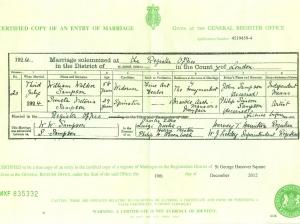
.
When I received copies of the transactions between Sampson and the Rosenbachs, they were on headed note paper, showing for the first time, the names of W.W.Sampson, and Henry Ramus, under the banner of ‘The British Galleries’, earliest date, 1909. On one of these dockets, a certain, ‘J.W. Godward’, was one of the artists named on the transaction, the very painter that Vern Swanson had written so extensively about, which resulted in me finding out about my Great Grandfathers business partner in the first place. Unfortunately the record didn’t mention the name of the Godward painting that the Rosenbachs had bought from William and Henry, but the transaction slips did detail a great deal of other prominent artists of the time, whose works they were sending across the Atlantic, among them, Sir Edward John Poynter, Dante Gabriel Rossetti, James Mc Neil Whistler, Sir Edward Burne Jones, to name but a few, and most of them either Pre Raphaelite, or loosely associated with. Virtually all the artists named seem to be of the classic school.
.
There were two other names as witness to William’s marriage, Charles Stone, and Luigi Naintre. I’ve not been able to locate Stone so far, although there is a mention in the Rosenbach biography, talking of Dr Rosenbachs visit to London in 1921, page 144, which reads:-
‘He hobnobbed with old friends of Philip, (Rosenbach), Bill Sampson and the Stones, London Jews in the furniture business and on the fringe of the entertainment world’
(The biographers were mistaken regarding Sampson being a Jew).
Luigi Naintre, however, turned up in Sir Harry’s biography, he was an Italian with a flair for the restaurant and entertainment business, or as Harry tells it:-(written 1936)
.
‘Luigi had been at Ciro’s Club, and there started a new era in fashionable entertaining. Ciro’s was in fact the forerunner of the night-life places of to-day. It provided a place where ladies could dine and dance with their men folk without being considered Bohemian and daring. The Prince of Wales and his brothers; Lord Louis Mountbatten and the beautiful Miss Edwina Ashley, whom he married; society beauties like the Hon. Mrs. Milford Haven and Lady Zia Wernher; the Marquis and marchioness of Carisbrooke; Lady Patricia Ramsey, Lady Mary Cambridge (now the Duchess of Beaufort) all these dined and danced at Ciro’s, and made it; and also inaugurated a new pleasure life era in town.
.
Luigi went on to the Criterion, which Solly Joel had bought, and Ciro’s declined. A remarkable man, Luigi Naintre. He began his career in England as a butlers assistant in a private house in Hampstead at a wage of 6 shillings a week. Then he went as apprentice waiter, or “commis” as it is called in hotel parlance, to the Savoy. From there he went to Romano’s. It was the best place for him to acquire the knowledge of human nature which later was so useful to him at Ciro’s and the Embassy.
.
After two years at the Embassy he sold control to a syndicate for, I believe, £42,000, and remained as managing director at a large salary. He had also a separate wine and cigar business, very thriving, which he started with a £1,000 note given to him as a tip by a maharajah pleased with his lunch’.
This passage was worth putting in here, as I believe the clubs around Piccadilly played quite a part in this story, with most, if not all, of the characters involved being members of, Ciro’s, Embassy, Criterion, and the Eccentric. These clubs all get a mention in Sir Harry Preston’s biography
.
The Other Dealers
.
As a result of the new found information from the Rosenbach Museum and Library, (which I sent along to Mr Swanson, having spotted the name of Godward), he kindly sent me back his record of the paintings by Godward, which Sampson had bought or sold at Christies. There were 48 Godward paintings in total. I also noticed the names of the other dealers coming up more than once, Francis Michael Evans, Henry Joseph Mullen, and William Lawson Peacock. After a quick search, it turns out that Henry Jospeh Mullen, like William Walker Sampson, grew up in Tynemouth, in the North East of England, no more than a couple of miles apart, they were also both employed as, ‘Stationers’, and ‘Commercial Clerks’, on their early census reports. They were even married at the same parish church of Jezmond, Newcastle, just one year apart, although Mullen is 9 years senior.
.
By 1891, I find Sampson living in South Park road, Harrogate, listed as a, ‘Solicitor’, staying with John and Fanny Potts, son and daughter of John Potts, a ‘Coal Owner’, from Wallsend, (which is within a couple of miles of where Sampson and Mullen grew up), and by coincidence, he happens to be just a five minute walk from Francis Michael Evans, who has his, ‘Art Galleries’, at 68 Parliament Street. (I wondered at this point, whether the Potts might be financial backers for this potential Ring)
.
Henry Joseph Mullen and his wife, Isabella, have a child, Arnold, in August 1896 at Whitley Bay, Tynemouth, and Henry gives his occupation on the certificate as, ‘Fine Art Dealer’.
When I check further in time on Mullen, he has also set up in Harrogate by at least 1916, listed in the phone book as, ‘Fine Art Dealer, 44 Parliament Street’. After a further bit of delving, I find that Henry Ramus’ cousin, Jacob Alfred Ramus, has moved up to Harrogate now, first at 23 Park Drive in the 1911 census, (occupation- Fine Art Dealer), and then at James Street, which spurs off Parliament Street, listed in the 1916 phone book as, ‘Fine Art Dealer’, continuing from his fathers business, Isaac Ramus, which had operated out of 87 Piccadilly, Mayfair, London, trading as, ‘Ramus brothers, Dealers in Works of Art’, just around the corner from Sampsons ‘British Galleries’ in Air street, and opposite the Royal Academy. When you consider the geographical differences of Tynemouth, Newcastle, Harrogate, and London, it stretches the imagination somewhat to consider these facts as one big coincidence, but that in itself is not concrete proof of some conspiracy, however, if as is more than plausible, Sampson were running an auction Ring, these characters must be prime suspects for membership.
.
William Lawson Peacock is less obvious as a potential member, but he is not without a coincidence or two himself, turning up at Paradise road, Dundee, Angus in the 1901 census, the same town that Henry Joseph Mullen and his family were living during the 1861 census. Henry’s Uncle, Joseph Rowell Mullen living there from at least 1861-71, before removing to Chorlton Upon Medlock by the 1881 census, (occupation- Engraver), around the corner from Joseph Ramus, another Picture Dealer, and also Henry Ramus’ father.
Peacock was born, (1852), and raised in his early years, (1861 and 1871 census),at Melville street, and North Bridge, Edinburgh, strangely enough, not a million miles from William Sampsons mother in law, who lived in Edinburgh between the 1871 and 1881 census, latterly in the Canongate district, the same district in which William Lawson Peacocks sister, Helen Elizabeth Peacock is living at the time. W.L. Peacock has an art gallery at 130 Princes street, Edinburgh, (as well as being a partner of the French Galleries at 120 Pall Mall, London), throughout this period. He also travels regularly to Montreal, Canada, on business, as do a good few of the extensive Ramus family, but that’s most likely just another coincidence, mind you, who really knows?.
.
Francis Michael Evans
Francis was born on the 29th September 1854, son of Walter Swift Evans, an engraver at this time, and Sophia Spilsbury. Walter had been at various times, a ‘Church Furniture maker, Engraver, and Gilder, employing men and apprentices. Francis was one of eleven children to Walter and Sophia, many of whom inherited their fathers natural artistic talents, going on to be artists, engravers, art dealers, publishers, and photographers.
.
By the 1871 census, Francis was working as a Church Furniture Maker, the same as his father on this census, by the time of his first marriage, in Bath, Somerset, 1880 to Sarah Wadham, (herself an art student according to the 1871 census), Francis’ occupation on the marriage certificate was, ‘Fine Art Dealer’, his address given as, ’20 Trevor Square, Knightsbridge, Middlesex’.
.
{His brother, Ernest Francis Evans, and Sarah’s sister, Mary Ann Wadham, were witnesses on the certificate, and they went on to marry each other three years later, also in Bath, April 1883. On the 1901, and 1911, census reports, Ernest was a Fine Art Dealer, living around the corner from Henry Ramus during this ten year period, both just a five minute walk from Finchley station in West Hampstead, London. I think it would be quite fair to assume, that as Henry and Ernest were both Fine Art Dealers, added to the connection of J W Godward between Henry’s business partner, W.W. Sampson, and Ernests brother, Francis Michael, they would have most likely known each other well, and indeed may well have shared many train journeys into Piccadilly and the heart of the art dealing world at that time. It might also be fair to assume that Ernest would at the very least have been aware of any art ring which Sampson was running, and not unreasonable to speculate that he may have played a part in the business. On the 1891 census, Ernests occupation was, ‘Dealer in Wines and Spirits’, so, as with many other of the characters in this story, it appears as if he may have jumped on the bandwagon which was the world of fine art dealing.}
.
Francis’ new wife gave birth to their daughter, Frances Mary Evans, on the 11th March 1881, at 32 Sherbrooke road, Fulham, but it would seem her birth came at the cost of her mothers life, who died within the month of giving birth. By 1886 Francis has remarried, to Isabella Helen Wiseman, at St Mary Magdalens church, Brighton, his home address given as, 32 Parliament Street, Harrogate, while Isabella’s address is, 2 Russell Street, Brighton.
.
By the 1891 census, Francis Michael is now living at 68 Parliament street, Harrogate, occupation, Fine Art Dealer, and it is about this time that I believe he may have first come into contact with William Walker Sampson, who was staying with John and Fanny Potts at Bedford Lodge, South Park Road, Harrogate, no more than a ten minute walk away. As I have mentioned earlier in this article, John and Fanny were children of John Potts, Coal Owner, and his wife, Sarah Ann, from Wallsend, Northumberland, which is next door to Tynemouth, Sampsons place of birth.
.
Francis’ eldest brother, Bernard Walter Evans, was a highly prominent artist, he studied painting in Birmingham from the age of 7 years under the direction of Samuel Lines, William Wallis, and Edward Watson.
.
Bernard married Mary Ann Eliza Hollyer at St Luke’s, Kentish Town in London on 2 August 1870. His wife was the daughter of Samuel and Mary Ann Eliza Hollyer; her father was an engraver, and her brother, Frederick Hollyer, was a pioneer in the field of photography. Bernard and Mary Ann lived in London, and Harrogate, as well as spending several winters during the late 1890’s on the French Riviera. From the time I began researching this story, this is the earliest link with any of the players, to Harrogate, here is a part of his obituary:-
.
‘For years he lived at Harrogate, his residence, which contained a splendid studio, being 20 Park Parade. Our readers will perhaps better identify the house when we say it was long known as “The Old Parsonage”, later as a club. Many winters Bernard Evans spent on the Riveria, where he obtained numerous subjects for his drawings.
He was for a long time a prominent member of the Savage Club, and many other artistic organisations. He spent much of his summer in sketching points of interest in various parts of the country, but he remained consistently faithful for many years to Yorkshire. He was a great colourist, and has often been likened to Turner in his strength and method. His pictures will be found in important galleries and municipal buildings all over the world. He had a sunny disposition and a strong sense of fellowship.
It is now some years since his wife, who inherited the artistic nature and talent, died, and if we mistake not, she was buried at Harlow Cemetery where Bernard Evans was interred on Thursday. When this artist left Harrogate the town lost a great feature of interest because his studio was always open to visitors, and he had interesting works besides his own.’
.
‘Bernard exhibited his art many times throughout the British Isles and abroad. His first works were shown in 1864 at the Royal Birmingham Society of Artists. Examples of his work can be viewed in our Gallery of Works and his major exhibition pieces are listed in the Exhibits pages.’
.
‘In 1880, whilst still living in London Bernard Evans was the driving force behind the creation of the City of London Society of Artists and in 1881 he was elected a member of the Savage Club. He was also a member of the Society of Artists which met at Langham Chambers, where groups of artists produced “Langham Club” Sketches.’
.
Bernards wife, Mary Ann, also came from a family rich in artistic abilities, not least of which, her brother Frederick Hollyer, a pioneer in photography, specialising in reproducing the paintings and drawings of prominent artists of the time, notably, Edward Burne Jones, D G Rossetti, and G F Watts, among many others. Frederick also took portrait photographs at his Pembroke Square studio in Kensington, including artists, writers, and actresses of the day. While I doubt that Frederick, or his brother in law, Bernard Evans, had anything to do with Sampsons ‘Ring’, it’s hard to imagine they didn’t know each other, and I wonder whether, as the so called, ‘Champion of British Art at Auction’, as Sampson was referred to in his obituary, he may not have been one of Frederick Hollyers subjects for portraiture.
.
Harrogate
Harrogate is a spa town in North Yorkshire, England, the town is a tourist destination and its visitor attractions include its spa waters and RHS Harlow Carr gardens. The town became known as ‘The English Spa’ in the Georgian Era, after its waters were discovered in the 16th century. In the 17th and 18th centuries the ‘chalybeate’ waters (i.e. containing iron) were a popular health treatment, and the influx of rich, and often sickly visitors contributed significantly to the wealth of the town. One of the results of this situation, was an opportunity for ‘art dealers’, ‘fine art dealers’, or ‘dealers in items of virtu’, to exploit these well heeled tourists, setting up art gallery shops around Parliament street, and surrounding roads, and bringing up their auction acquisitions from the London auction houses, possibly especially chosen for this elite clientelle.
.
Here, courtesy of Vernon Grosvenor Swanson, are records of the provenance of two J.W.Godward paintings that involve Sampson, Peacock, and Evans together:-
A QUIET PET
On the Terrace
The Pet
1906
oil on canvas, 20″ x 30″ (50.9 x 76.2 cm)
signed and dated lower, “J. W. Godward 1906”
Prov: Messrs. Francis Michael Evans, “Art Galleries” Harrogate, 24 May 1906; Sir Charles C. Wakefield, sold Christie’s London, 18 Jun 1909 (136) for £110 5s; bt. Messrs. Francis Michael Evans, “Art Galleries,” Harrogate, Yorkshire; Messrs. W. W. Sampson, The British Galleries, London, sold in Mar of 1911; bt. Messrs. W. L. Peacock, London, sold in Apr 1911; bt. Mr. Mungall-Creiff; The Leger Galleries, London, by May 1973; sold Phillips London, Jun 1996 (private treaty); sold to Frederick C. and Sherry Ross, Essex Fells New Jersey; sold Sotheby’s New York, 12 Feb 1997 (82) for $277,500; bt. Jerome and Susan Davis, to the present.
.
IN THE LAND OF DREAMS: A SUMMER’S DAY
by Jul 1905
oil on canvas, 27-3/4″ x 23-1/2″ (70.5 x 59.7 cm)
signed and dated
Prov: Messrs. Francis Michael Evans “Art Galleries”, Harrogate, 31 Jul 1905; Charles C. Wakefield, sold Christie’s London, 18 Jun 1909 (137) for £89 5s; bt. Messrs. W. W. Sampson, The British Galleries, London, sold 24 Jun 1909; bt. French Gallery, London, sold 1910; bt. Messrs. Bennett Brothers, Montreal Canada, sold 13 Mar 1911; bt. Messrs. William Lawson Peacock, London, sold Mar 1911; bt. Messrs. W. W. Sampson, London; present location unknown.
So, not only did these characters coincidentally choose the same vocation, locations, and train stations, but they also appear to share an appreciation for the same artist.
Some Vernon Grosvenor Swanson notes from his, ‘Eclipse of Classicism:-
.
3. Christie’s London auction sold the first portion of the stock of W. W. Sampson owing to the death of Henry Ramus ( -1911), a partner in the Firm, occurred on Saturday November 18th and Monday November 20th, 1911. No Godward’s were among the group sold.
4. The Year’s Art 1910, p.29. The advertisement states that they have a specialty works “for reproduction.” The list of twenty-one artists mentions Godward and W. Anstey Dollond as their only classical artists. It concludes with “Special Terms to the Trade.” Who’s Who in Art 1927 p.203 notes that he began in the trade in 1887. It also notes that he was a member of three clubs in London; Embassy, Ciro’s and the Eccentric.
5. The Year’s Art 1930, pp.299-300. He was succeeded in business by his son Jack Sampson.
6. The Daily Telegraph (2 Nov 1929) He died on the 31st of October, according to David Mason and John Williams, drunk in his bath-tub.
7. James Mason and John Williams explains that the, now illegal, “Ring” was controlled by W. W. Sampson.
.
Abraham Simon Wolf Rosenbach
.
Researching the Rosenbach brothers, Philip, and Abraham, has given this article an important view into the auction rooms of the time, and the world that these auction room bidders occupied, as well as the people behind them, the money men that have the financial wherewithal, but not the time to spend it themselves.
.
With the books written by, and about, Dr. A.S.W. Rosenbach, as well as the online archives of immigration and census reports, I soon built up a picture of events surrounding Abraham, (Abe to his friends), and his brother, Philip. The earliest trip across to England for Philip, that I have a record for, is in 1903, when he sailed to England with Clarence Bement, (a shareholder in the newly formed Rosenbach Company), to, “establish lines of Credit”. Abraham’s first trip was in April 1907, between them, they shuttled back and forth across the Atlantic numerous times over a thirty, odd, year period, attending major auction room sales. Abraham came for rare books, folios, and manuscripts, while Philip came to London for art, and the high life, (although in fairness his younger brother later came to out do Philip in the high living stakes).
.
When in London, Abe had bids in his pocket from the industrial might of America, the likes of Henry E Huntington, a railway magnate, J. P. Morgan, financier and banker, Henry C Folger, an oil business man, among many others. In those heady days of stock market fluctuation, coupled with the emergence of America as the new financial heavyweight of global affairs, rare books, or ‘Incunabula’, were not just an expensive hobby for these extremely rich men, these books also represented a safe haven for their money, apparently unaffected by the markets ebbs and flows, and Dr Rosenbach had an almost unparalleled knowledge of these old books. From 1907 to 1930, the Rosenbach’s sailed between Europe and America relentlessly, gradually transferring the balance of literary power to the newly forming American libraries, paid for by the new business elite. These same men of industry, were also building art collections, seemingly competing with each other in their bid to later achieve immortality by their beneficence to the New Worlds institutions as they sought to create some meaning for their existence.
.
In January 1922, the Doctor came to London for the Britwell Library sale, a collection of rare books the like of which seldom come to auction. Over the five days of the sale, bringing £80,259, the Doctor had paid £64,697 for his lots, £16,618 was for himself, the rest on behalf of his wealthy book hound customers in the U.S. To give some idea of the amounts being bid by todays values, using a price comparison calculator, the £64,697 that the Doctor bid, would be worth between £3,190,000, and £21,200,000 now.
Here is an excerpt from Edwin Wolf, and John Fleming’s biography of A.S.W. Rosenbach, which gives a little flavour of the time, (as well as giving a contemporary description of William Walker Sampson), pages 155/6/7:-
‘At the end of February, 1922, just before Dr. Rosenbach left for home, he gave a victory dinner at the Carlton. The small but distinguished company included E.V.Lucas, Arnold Bennett, Hugh Walpole, John Drinkwater, and William Sampson, the Doctors London crony.’
.
Further on it says:-
.
‘With one important sale following after another in London with such frequency, the Rosenbach brothers literally shuttled across the Atlantic. No sooner did Dr Rosenbach reach home than preparations had to be made for Philip’s trip over. It had been announced that the fine First Folios which had belonged to the Baroness Burdett-Coutts, in her day the richest heiress of England, were to be sold at Christies. While he was still in London, the Doctor had suggested to Folger that they might be bought by private treaty if he were willing to offer a high enough price for them. Dr. R got back his answer in three cables spaced a day apart: “£12000 FOR TWO FOLIOS SEEMS EXCESSIVE,” “IF NECESSARY PAY £12000 USE SECOND MESSAGE IF DESIRABLE,” and “WISH FOLIOS.” The heirs of the baroness-banker felt that the disappearance of the two principle items would hurt the sale and decided to take their chance under the hammer.
The sale included portraits and relics as well as books. Sensing that publicly shown Rosenbach interest in anything might raise prices, the Doctor advised Henry Folger, who was determined to get the folios in competition which he had failed to buy privately, that he would play an unusual, unobtrusive role. The portraits would not be bought under the Rosenbach name, but under that of friend Bill Sampson, a major buyer at Christie’s, which would eliminate his competition and keep Rosenbach’s name out of the limelight:’
.
E.V.Lucas, Arnold Bennett, Hugh Walpole, John Drinkwater, were all renowned writers of the time, and by reading the biography of Sir Harry Preston, it can fairly be stated that they were all part of a familiar circle of friends, which along with, Sampson, Rosenbach, and Preston, included many of the most eminent names in art, literature, sport, invention, and business. I find it hard to believe that a run of the mill art dealer would find himself in the company of such men, let alone be regarded so highly by them, and it is a telling comment in the biography, “friend Bill Sampson, a major buyer at Christie’s, which would eliminate his competition”, as strong an indication as I’ve seen so far to back up the theory that Sampson may indeed have been at the head of a dealers ring, otherwise by what method might he be able to eliminate opposition in the auction room?
.
Over the years, the Doctor, as he was referred to in the newspapers, became a regular of the front pages in Britain, and never with more fanfare than when he outbid allcomers for Lewis Caroll’s, original manuscript of, ‘Alice in Wonderland’, in April 1928 at Sothebys in London, carrying the prize away for £15,400. Paintings were going for far higher prices that year in London, with Remrandt’s, ‘A Man Holding the Torah’, going for 48,000 Guineas, and Joseph Duveen announcing that he had bought Raphael’s, ‘Niccolini-Madonna’ for $875,000 from Lady Desborough, but these paintings didn’t hold the public imagination anything quite like ‘Alice’, or many of the other literary titles that the Doctor whisked away from these shores.
.
When Dr. Rosenbach sailed for home aboard the Majestic from Southampton on the 23rd May 1928, William Walker Sampson, and his wife, Simeta, were both aboard too. It is on this ships passenger lists that we get a description of William, 5’7″ tall, with fair complexion, dark hair, and blue eyes. W.W names Dr. A.S.W. Rosenbach, 1320 Chestnut street, Philadelphia, as the friend he would be staying with, the Book King, and the Lord of the Ring.
.
Before William died on the 31st October 1929, it would seem his business must already have been suffering, as he only left ten pounds in his will, although he may have had properties. Given the time though, just two days after the, ‘Black Tuesday’, stock market crash of Wall Street, as well as the movement in the art world away from the classic style, to Modernism, it’s possible to see that for someone that had spent the majority of his art dealing career collecting the work of classic style artists, this two pronged attack would have been difficult to take. His death certificate states that he died of a heart attack, although the symptoms of this attack can apparently often be the result of heavy drinking. It is well documented that Dr Rosenbach had a definite taste for scotch, getting through a bottle a day at times, and when I informed Patrick Rodgers of the Rosenbach Museum and Library of how William allegedly died, (he was rumoured to have died while inebriated in his bath), his response was, “What a way to go for William! I hope Dr. R. didn’t give him a bad example during their times together”.
.
Sir Harry Preston
While for this article, it may be stretching things a bit to include Sir Harry, I believe there are enough links to convince the reader he has a place in the story. When Harry first came to Brighton around 1900, he was running a hotel in Bournemouth while at the same time trying to reverse the fortunes of the Royal York Hotel on Brighton seafront. Prior to Bournemouth, he had worked as a shipping clerk in London, before turning his hand to run pubs in Holborn, Hackney, and Lambeth.
.
I first came across the name of Harry Preston as he was one of the witnesses at W.W. Sampsons wedding to Simeta Sampson in 1924, so I began investigating his life too, and was fortunate to find he had written two autobiographical books, both of which mention William Walker Sampson. It is only after having read his biography, as well as having traced his life through ancestry records, that the links make him part of the story. He also mentions a Loving Cup, and a commemorative silver salver, which were presented to him by close friends, Sampsons name being inscribed on both, handily, there is a picture of the salver in his, ‘Leaves from My Unwritten Diary’, which has many eminent names of the day, not least of which, a certain ‘Edward’, Prince of Wales. You can see, ‘W.W.Sampson’, just below the date, 1927, and, ‘Edward’, just above the word, ‘presented’.
.
Harry was known firstly as an Hotelier, a huge sports fan, especially boxing, also as an art patron, as well as a major organiser of charitable events to raise money for Brighton hospitals. Mainly though, as Sampson is the focus of this article, their friendship, and shared friends, make the inclusion of Harry Preston an important factor in explaining the time they lived in.
.
Born John Henry Preston, on the 19th February 1860, the son of John Lovesey Preston, a solicitors general clerk, according to his fathers wishes, young Harry started his working life as a teacher, but soon decided this was not the life for him, and he made his way to the docks of London, finding employment as a shipping clerk.
.
Part of his game plan for Brighton, was to restore the publics faith in the town, which, to this end, included convincing the local council to cover Madeira Drive, next to the Palace Pier, in the latest road surfacing of the time, ‘Tarmac’, in order to hold the first speed trials there in 1905. Among the many drivers that gathered that July for this ground breaking event, was Dorothy Levitt, a former secretary at the engineering company, Napier and sons, in Vine street, Lambeth. She was convinced by Selwyn Edge to race for Napier Cars, which Edge owned, and soon made her name in the motor racing world, setting the Ladies World Land speed record at Brighton in 1905.
.
Napier and sons was owned by Montague Stanley Napier, an engineering pioneer who would go on to design not just motor cars, but aeroplane engines too. Napier also happens to be found on the provenance of two J.W. Godward paintings, Dolce Far Niente (1908), and Pharoahs Favourite (1920). Given that Harry Preston was the driving force behind the speed trials held at Brighton, I think it highly unlikely that he wouldn’t know Montague S Napier, indeed, having read Harry’s biography, I would expect him to have actively sought him out, such was his interest in all things to do with this new world of mechanical engineering. The Napier company also designed and built motor boats, another passion of Sir Harry Preston. In fact, given all the ties that the various characters in this article have to Brighton, I can well imagine a large majority of them being at Madeira Drive on the 19th to 22nd July 1905 for what was a world event at the time, Francis Michael Evans daughter, Frances Mary, was married in the town only a week earlier.
.
Next up we have Sir Charles Cheers Wakefield, another pioneer, this time in the world of lubricating oils for the ever advancing machines and engines that were being invented for use on land, water, and air. He coined the product name of ‘Castrol’, based on the fact the early engine oils had a large proportion of castor oil in them. Sir Charles is on the provenance for two of Godwards paintings, ‘In the Land of Dreams’, (18 June 1909), and ‘A Quiet Pet’, (18 June 1909). I think it’s fair to assume that plenty of the cars racing at the 1905 speed trials at Madeira Drive would have been using Sir Charles revolutionary oil lubricants, and just as likely that he would have been there to see it, quite possibly enjoying Harry Prestons hospitality at the Royal York Hotel too. He went on to develop oils for the evolving air industry too, so Wakefield and Napier would doubtless have been working on several projects together as a matter of necessity.
.
Sir Merton Russell Cotes, very much an art patron in his time, is on the provenance of at least three Godward paintings, two of which he sold at auction on the 11th March 1905, ‘A Priestess’, and ‘Dolce Far Niente’, while, ‘Portrait of Miss Ethel Warwick’, he bought on the 1st June 1917. He also happened to be an hotelier in Bournemouth, running the Bath Hotel, renaming it as the, ‘Royal Bath Hotel’, during the same period that a certain Harry Preston was also running a hotel in that town, and had been chairman of the Bournemouth Hotels Association.
While I accept that Sir Harry Prestons link to any art ring is tenuous at best, I believe it’s fair to say he would have known a great deal of the players in such a ring, although, having read his biography, there don’t seem to be many people of note he didn’t have an acquaintance with. Certainly he was a close friend of William Walker Sampson, and he talks of attending auctions in his book, and was a member of the same clubs around Piccadilly that Sampson was.
Tags: auctions, brighton, Christies, J.W.Godward, Knockout, Majestic, Olympic, Rosenbach, Royal Academy, Sothebys, The Ring, White Star Line
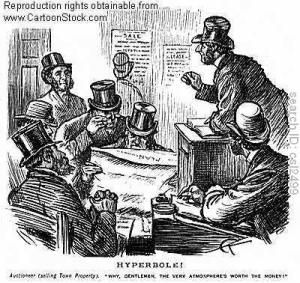
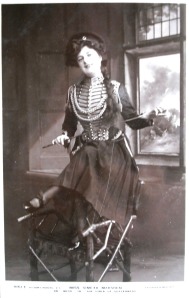
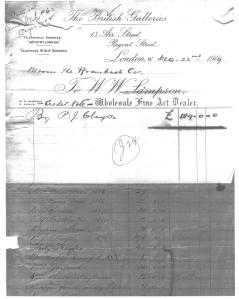
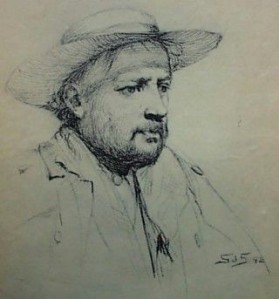
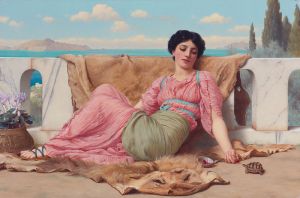
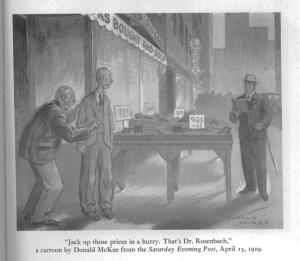
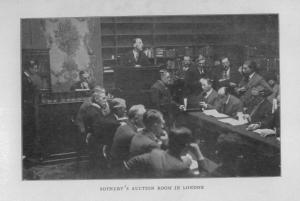
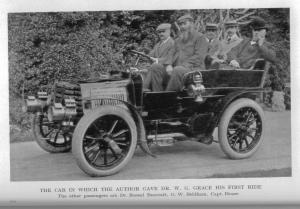
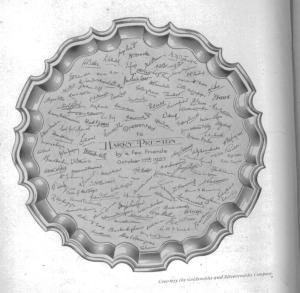
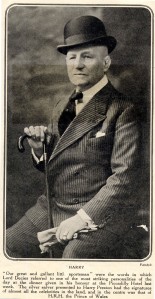
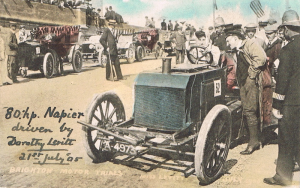
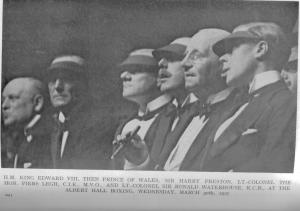
January 6, 2014 at 5:03 am |
I have a family painting sold to us through W.L, Peacock (original receipt on file) on 1906 in Montreal that is supposed to be Warren Hastings by Sir Joshua Reynolds. This seems to be not the case and we want to discover the true identity of portrait and painter. If you are interested in this case, there is a reference at the Getty archive of Thomson of the French Gallery writing four pages on a disputed Reynolds painting when WL Peacock was a partner.
Any feedback would be appreciated.
January 6, 2014 at 8:49 am |
Hi, I’m sorry I can’t help, I’m not an art expert, but I’ll ask Vern Swanson, who is.
Thanks for looking in, I hope you enjoyed the Godward story, it’s an ongoing thing.
With kind regards,
Andy Ramus
January 6, 2014 at 6:21 pm
Thanks for the response. I would appreciate your passing this on. I appreciate your blog posting as I had no idea this type of conversation was happening. Great context for filling in the void of a family mystery.
DW
January 7, 2014 at 6:22 am |
No problem David,
is there a link to that Getty archive info? I still expect to find more connections between Montreal and London in this story, so any extra information would be gratefully received. Anything to do with Peacock, Montreal, or auction houses, all adds to the bigger picture of the art world at that time.
Andy R
January 7, 2014 at 8:01 pm |
http://www.npg.org.uk/collections/search/portrait/mw02979/Warren-Hastings
Is this the picture you have?
January 7, 2014 at 11:40 pm |
No. That’s the problem, JR is only known to have done 1 portrait of WH and the likeness to ours is different. I sent you an email with an attachment of the painting and bill of sale. Did you get it?
The image on my Google+ is the painting.
DW
January 8, 2014 at 7:06 am |
I received a message here, but the links came up as ‘page not found’. Maybe if you e mail me at wolf_e_boy@hotmail.com it may come through ok, and I’ll forward it to Vern Swanson. Obviously I can’t make promises on his behalf, but as an art historian it should intrigue him at least.
Regards,
A.R
January 8, 2014 at 7:09 am |
It’s a funny coincidence also, as I have been researching the Bengal Pilot Service as part of my friends family tree, which involves the East India Company too.
April 22, 2014 at 6:45 am |
Reblogged this on Wolfeeboy’s Blog.